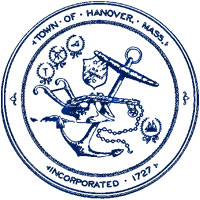History of Hanover Public Schools

Salmond School
Originally constructed in 1931, the building sits on the site of one of the original schools for the Town of Hanover (1852). In 1931 the original white clapboard schoolhouse was relocated to another town and the new (current) building was constructed along with the original 400 lb. bell housed in the belfry as a reminder of the original school. The school housed grades 1 through 6 until 1978 when the school district consolidated due to financial reasons and the students were assigned to Cedar school. Two years later the building was leased by a private daycare/preschool center. From 1997 to 2000, the building temporarily became home to the Hanover Public Schools pre-kindergarten and kindergarten classes. Pre-kindergarten and kindergarten students began attending their district schools, Cedar and Center Elementary School, in September 2000 when renovation and addition projects were completed.
As of November 2002, Salmond School became the site of the school administration offices; the hub of the educational and instructional programs; the core resource for educational programs for mandatory professional development for staff; the repository of curriculum; the instructional space for in-service and curriculum institute related programs of curriculum development; and the organizational working and meeting place for the Curriculum Council, School Committee, Health Advisory Council, Parent Advisory Council, Strategic Planning Committee, Technology Committee, Healthy Schools Committee, Superintendent Roundtables, and the School Building Needs Committee. The meeting areas and classrooms at Salmond are used by the schools as a site to provide instruction and training related to the educational programs of the schools and by educational study groups and task forces, which are assessing and developing academic resources and programs. Educational organizations and community groups use these facilities. The superintendent of schools, the pupil personnel services administrator, the business manager, the school committee, and all business and administration offices, which do the work and provide the services, related to the educational programs, academic functions, personnel management, facilities, and operation of the schools are at Salmond School.
Hanover High School
Hanover High School serves grades 9 through 12. The building, designed by J. Williams Beal & Sons Architects, was constructed in 1958 with a classroom wing addition in 1962. The building sits on a building lot that abuts the Middle School and Cedar School sites with a combined land area of approximately 101 acres. The Drinkwater River flows across the center of the site.
Hanover Middle School
Hanover Middle School serves grades 5 through 8. The building was designed by Korflund, Lenormand & Quann, Inc., and was constructed in 1972. Renovations and an addition were completed September 2000.
Cedar Elementary School
The Cedar Elementary School houses approximately 30 classroom spaces where instruction takes place on a daily basis. The school also has a kitchen, cafeteria, staff/volunteer workroom, gymnasium, media center, music classroom, and visual arts classroom. The grounds surrounding the school are enhanced by work of the school beautification committee, a sub group of the PTA. The children have access to 3 developmentally appropriate playgrounds and many open spaces for play and organized games. Each morning, one 4th grade class follows the tradition of raising the flag in the front of the school and leading the Pledge of Allegiance to start the school day. The building was designed by Perley Gilbert Associates, and was constructed in 1966. Renovations and an addition were completed September 2000.
Center Elementary School
Center School serves Pre-Kindergarten to grade 2. The building was designed by J. Williams Beal and Sons Architects, and was constructed in 1953. Renovations and an addition were completed September 2000.
Sylvester School
Sylvester School, originally designed by J. Williams Beal and Sons Architects, as the Town's high school in 1927, now serves grades 3 and 4. Although the building is not listed on the National Register of Historic Places, it is located in the National Historic District of Hanover Center. The site, at one time, had a one-room schoolhouse located here as well. The building stands virtually the same as originally constructed except for an addition in 1960 when the then new High School was built. The building was converted to a junior high school, later housed 5th and 6th grades, 5th grade only, 4th grade and one-half of the 5th grade population, and now houses grades 3 and 4. The combined site of Center and Sylvester Schools is approximately thirty-three (33) acres; an aquifer boundary line passes through the center of the site.
Town of Hanover Seal
James C. Waterman, at age 20, designed the Hanover Town Seal, which was simplified and is used today as the Official Seal of the Town. Waterman received a letter of appreciation and congratulations from the Board of Selectmen, which is now framed with the original seal and displayed at the Stetson House.
Hanover's early economy was based on agriculture and lumbering. The lumber was used for house building and shipbuilding, while other early industries included grist mills and iron forges. By the 18th century, the town had made itself a very self-sufficient community on a sturdy agricultural and industrial foundation, with a wealth of water power re sources and a shipbuilding complex on the North River. Hanover was in fact one of the major industrial centers of southeastern Massachusetts at the time. Thirty ships were built in 1801 on the North River and the town's anchor forges made the anchors for the United States Navy and are said to have supplied the anchor for the U.S. Constitution.
sources and a shipbuilding complex on the North River. Hanover was in fact one of the major industrial centers of southeastern Massachusetts at the time. Thirty ships were built in 1801 on the North River and the town's anchor forges made the anchors for the United States Navy and are said to have supplied the anchor for the U.S. Constitution.
Unfortunately, a market for larger ships than the North River could hold ended the shipbuilding industry in Hanover. The town was the site of the invention of the first tack-making machine, and making tacks and fireworks were among the industries of the later 19th century for Hanover. These manufacturing jobs brought immigrants from Lithuania and Poland, who established their own settlements within the town. However, the most significant post-civil war movement was toward residential subdivision development as the main roads from Brockton and Boston were improved in the 20th century. Residents are proud of the Four Corners Section of Hanover, which retains its authentic period village character, and of their close-knit and friendly town. The Hanover Town Seal proudly displays the early agricultural and ship-building history of the Town.

